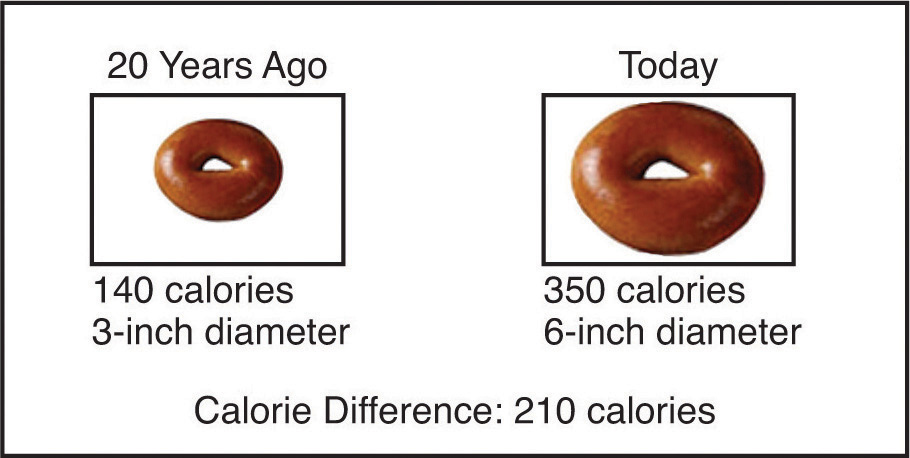This is “When Enough Is Enough”, section 2.8 from the book An Introduction to Nutrition (v. 1.0). For details on it (including licensing), click here.
For more information on the source of this book, or why it is available for free, please see the project's home page. You can browse or download additional books there. To download a .zip file containing this book to use offline, simply click here.
2.8 When Enough Is Enough
Learning Objective
- Judge food portion sizes for adequacy.
Estimating Portion Size
Have you ever heard the expression, “Your eyes were bigger than your stomach?” This means that you thought you wanted a lot more food than you could actually eat. Amounts of food can be deceiving to the eye, especially if you have nothing to compare them to. It is very easy to heap a pile of mashed potatoes on your plate, particularly if it is a big plate, and not realize that you have just helped yourself to three portions instead of one.
The food industry makes following the 2010 Dietary Guidelines a challenge. In many restaurants and eating establishments, portion sizes have increased, use of SoFAS has increased, and consequently the typical meal contains more calories than it used to. In addition, our sedentary lives make it difficult to expend enough calories during normal daily activities. In fact, more than one-third of adults are not physically active at all.

As food sizes and servings increase it is important to limit the portions of food consumed on a regular basis.
Dietitians have come up with some good hints to help people tell how large a portion of food they really have. Some suggest using common items such as a deck of cards while others advocate using your hand as a measuring rule. See Table 2.11 "Determining Food Portions" for some examples.American Cancer Society. “Controlling Portion Sizes.” Last revised January 12, 2012. http://www.cancer.org/Healthy/EatHealthyGetActive/TakeControlofYourWeight/controlling-portion-sizes.
Table 2.11 Determining Food Portions
| Food Product | Amount | Object Comparison | Hand Comparison |
|---|---|---|---|
| Pasta, rice | ½ c. | Tennis ball | Cupped hand |
| Fresh vegetables | 1 c. | Baseball | |
| Cooked vegetables | ½ c. | Cupped hand | |
| Meat, poultry, fish | 3 oz. | Deck of cards | Palm of your hand |
| Milk or other beverages | 1 c. | Fist | |
| Salad dressing | 1 Tbsp. | Thumb | |
| Oil | 1 tsp. | Thumb tip |
Video 2.5
Managing a Healthy Diet: Judging Healthy Portion Sizes
(click to see video)A dietitian shows how to compare food sizes with hands and other objects.
MyPlate Planner
Estimating portions can be done using the MyPlate Planner. Recall that the MyPlate symbol is divided according to how much of each food group should be included with each meal. Note the MyPlate Planner Methods of Use:
- Fill half of your plate with vegetables such as carrots, broccoli, salad, and fruit.
- Fill one-quarter of your plate with lean meat, chicken, or fish (about 3 ounces)
- Fill one-quarter of your plate with a whole grain such as ⅓ cup rice
- Choose one serving of dairy
- Add margarine or oil for preparation or addition at the table
Table 2.12 Meal Planning Guidelines
| Carbohydrates | Meats/Proteins | Fats | Free Foods |
|---|---|---|---|
| Choose three servings with each meal. | Choose one to three servings with each meal. | Choose one to two servings with each meal. | Use as desired. |
| Examples of one serving: | Examples of one serving: | Examples of one serving: | Examples |
|
Breads and Starches
|
|
|
Foods with less than 20 calories per serving.*
|
|
Fruits
|
|||
|
Milk
|
Key Takeaway
- Judging portion sizes can be done using your hand or household objects in comparison. It can also be done using the MyPlate guide to determine how much food is a portion for that meal.
Discussion Starter
- Why is it important to judge portion sizes properly? Explain why it can be tricky to read food labels and figure out the caloric content for one serving.




